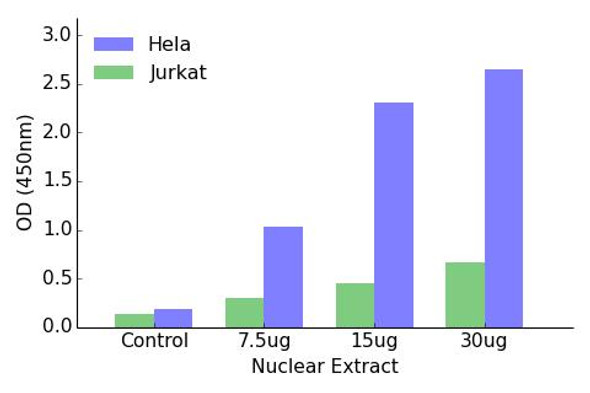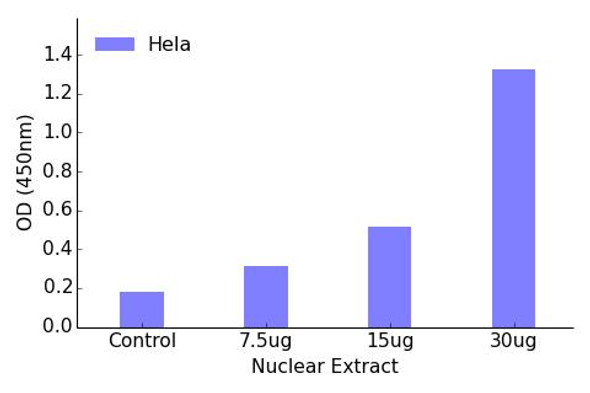Description
NCoR1 Transcription Factor Activity Assay
The NCOR1 Transcription Factor Activity Assay Kit is a powerful tool for studying the regulatory role of NCOR1 in gene transcription. This kit allows for the quantification of NCOR1 activity in various samples, such as cell lysates or tissue homogenates, providing valuable insights into the molecular mechanisms underlying gene regulation.NCOR1 is a critical transcriptional corepressor that plays a key role in modulating gene expression and maintaining cellular homeostasis. Dysregulation of NCOR1 activity has been linked to various diseases, including metabolic disorders, cancer, and neurological conditions.
Therefore, understanding the function of NCOR1 is essential for elucidating disease mechanisms and identifying potential therapeutic targets.With its high sensitivity and specificity, the NCOR1 Transcription Factor Activity Assay Kit offers reliable and reproducible results, making it suitable for a wide range of research applications. Researchers can confidently analyze NCOR1 activity and its impact on gene expression, paving the way for innovative discoveries in the field of transcriptional regulation.
| Product Name: | NCoR1 Transcription Factor Activity Assay |
| Product Code: | TFAB00136 |
| Target: | NCoR1 |
| Reactivity: | Human |
| Sample Types: | Nuclear or cell lysates |
The Assay Genie NCoR1 transcription factor activity assay allows for the detection and qualitative analysis of endogenous levels of activated transcription factors in a variety of nuclear and cell lysates
Assay Genie ELISA kits are designed to significantly reduce experiment time and ensure sensitivity and flexibility for high-throughput screening.
| Assay Time: | 4.5 hours |
| Detection Method: | Colorimetric 450 nm |
| Size: | 12 x 8-Well Microstrips |
| Storage: | 4°C for 6 months |
| UniProt Protein Function: | N-CoR1: is a protein that regulates the activity of some transcription factors, including nuclear receptors, by promoting histone deacetylation and chromatin condensation, thereby altering the accessibility of various genes to the transcriptional machinery. Is known to play a role genetic programming including that for myogenesis. Is a component of a large corepressor complex that contains SIN3A/B and histone deacetylases HDAC1 and HDAC2. This complex associates with the thyroid and the retinoic acid receptors in the absence of ligand. Interacts with the catalytic domain of HDAC9. Increased expression correlates with the loss of vitamin D responsiveness in aggressive androgen-independent prostate cancer cells. Its gene tends to be overexpressed in multiple-myeloma cell lines. |
| UniProt Protein Details: | Protein type:Nuclear receptor co-regulator; Transcription, coactivator/corepressor Chromosomal Location of Human Ortholog: 17p11.2 Cellular Component: histone deacetylase complex; membrane; nuclear chromatin; nucleoplasm; nucleus; Sin3 complex; spindle microtubule; transcriptional repressor complex Molecular Function:histone deacetylase binding; ligand-dependent nuclear receptor binding; nuclear hormone receptor binding; protein binding; thyroid hormone receptor binding; transcription corepressor activity Biological Process: cellular lipid metabolic process; circadian rhythm; negative regulation of JNK cascade; negative regulation of transcription from RNA polymerase II promoter; spindle assembly; transcription from RNA polymerase II promoter |
| NCBI Summary: | This gene encodes a protein that mediates ligand-independent transcription repression of thyroid-hormone and retinoic-acid receptors by promoting chromatin condensation and preventing access of the transcription machinery. It is part of a complex which also includes histone deacetylases and transcriptional regulators similar to the yeast protein Sin3p. This gene is located between the Charcot-Marie-Tooth and Smith-Magenis syndrome critical regions on chromosome 17. Alternate splicing results in multiple transcript variants. Pseudogenes of this gene are found on chromosomes 17 and 20.[provided by RefSeq, Jun 2010] |
| UniProt Code: | O75376 |
| NCBI GenInfo Identifier: | 47117817 |
| NCBI Gene ID: | 9611 |
| NCBI Accession: | O75376.2 |
| UniProt Secondary Accession: | O75376,Q86YY0, Q9UPV5, Q9UQ18, B3DLF8, E9PGV6, |
| UniProt Related Accession: | O75376 |
| Molecular Weight: | |
| NCBI Full Name: | Nuclear receptor corepressor 1 |
| NCBI Synonym Full Names: | nuclear receptor corepressor 1 |
| NCBI Official Symbol: | NCOR1 |
| NCBI Official Synonym Symbols: | N-CoR; TRAC1; N-CoR1; hN-CoR; PPP1R109 |
| NCBI Protein Information: | nuclear receptor corepressor 1 |
| UniProt Protein Name: | Nuclear receptor corepressor 1 |
| Protein Family: | Nuclear receptor corepressor |
| UniProt Gene Name: | NCOR1 |
| UniProt Entry Name: | NCOR1_HUMAN |






